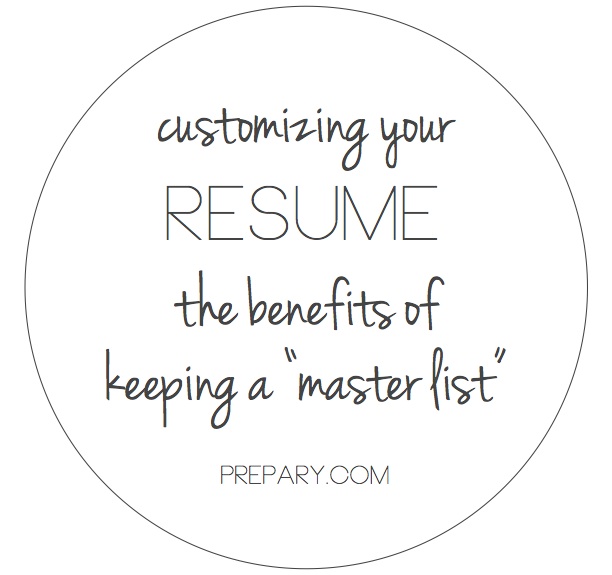In order to have a really compelling resume for a specific company or job, it’s necessary to tailor your resume to that company or job.
There are lots of tips and tricks on how to customize your resume and for today’s post we’re going to talk about the value of keeping a “master resume list”. I assure you that keeping this around will make your life way easier.

So what is a “master resume list”?
A master resume list is a total data dump of every responsibility you’ve held at every job, school, or internship you’ve been at. While your final resume should only have 3-5 bullets per job, chances are you’ve done many more tasks than that.
Not every accomplishment can make it into every resume, but it’s important to keep track of all the other things you accomplished while they are fresh in your mind. When you’re making your master resume list, jot down as much detail as possible and you can always narrow it down later.
Provide bullets of what you were responsible for and attach results whenever possible. As an example, take the responsibility of “Organized sample closet and created check out process to ensure product would always be available for shoots and press” and add on “Putting this process in place reduced lost items by 40%“.
I recommend organizing this list by job title & company in chronological order.
How often do I need to update it?
The key to keeping this master list current is updating it at least every time you switch jobs. If you wait too long it will be harder to remember what you’ve done.
If you are someone who is staying at one company for many years, I’d suggest checking into the master list at least every year and adding on any new responsibilities.
The more you wait, the harder it will actually be to write your bullets. The process of updating the list shouldn’t feel cumbersome. It’s really just getting everything you are already doing on paper (no need to make it pretty or perfect – that comes later).
How will this help me improve my resume?
Well, customizing your resume is key… and having a “bank” of things to draw from and pop in, makes this process a lot less daunting than it would be otherwise. Especially when considering different types of industries and roles, one size does not fit all.
When you’re ready to customize your resume for a specific job, first hit up the job description and read it really carefully.
- What is the company looking for?
- What skills are important to them?
- Most importantly, what day to day tasks and responsibilities are listed? Do any seem familiar?
After really understanding the job description, it’s time to go to your master resume list. Look through each job and experience and decide what would be most relevant to showcase. Not only should you choose your bullets carefully, but also feel free to order them from most relevant to least.
Resume readers have short attention spans, and it’s important to put your best foot forward.
Keep in mind, anything you’ve done in your past jobs that was a huge chunk of your day (or year) should always be listed. Customizing is one thing but you don’t want to cross the line and misrepresent your experience.





